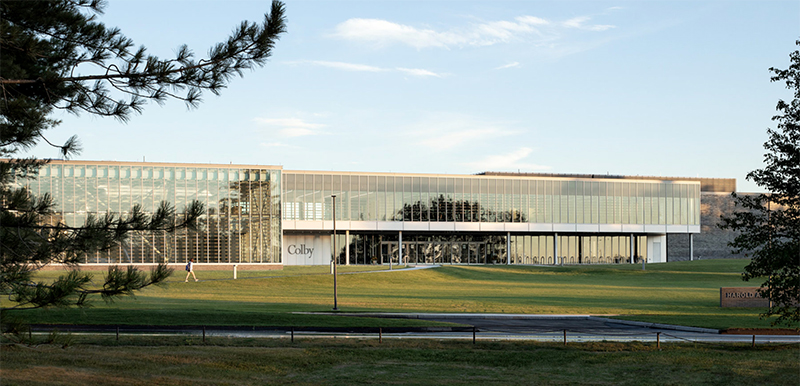Sasaki and Hopkins Architects designed Colby College Alfond Athletics Center earns LEED and SITES certifications

Waterville, ME According to Sasaki and Hopkins Architects, the Colby College Harold Alfond Athletics and Recreation Center has received both LEED Platinum and SITES Gold certification status. Awarded by the U.S Green Building Council, Platinum status is the highest LEED certification a project can attain. SITES Gold is awarded by SITES, a comprehensive rating system designed to distinguish sustainable landscapes, measure performance, and elevate value.
The 350,000 s/f Colby College building, which opened in August 2020, is a modern facility transcending conventional athletics and recreation center design. The building includes a multi-use fieldhouse with a 200-meter track and tennis courts, an ice arena, an Olympic-sized pool, a competition gymnasium for basketball and volleyball, squash courts, a strength and fitness center, and multi-purpose studios, supported by locker rooms, sports medicine facilities, and offices. The building provides Colby College with one of the largest and most comprehensive athletics facilites in Division III.
“The Sasaki team, in conjunction with Hopkins Architects and all of our tremendous project partners, are thrilled the Harold Alfond Athletics and Recreation Center achieved LEED Platinum and SITES Gold,” said Chris Sgarzi, a principal architect at Sasaki and a leader in the firm’s sports practice. “Colby College is a demonstrated leader in sustainability and committed to maintaining its carbon neutral status, so this project was especially focused on the health and wellness aspect of both the environment and students, faculty, and staff who utilize the facility. Receiving these certifications is a wonderful way to showcase all the spectacular features of the building and site.”
Sgarzi said that core sustainability principles related to indoor air quality, daylight and views, thermal comfort, and building performance are seamlessly integrated into the facility and site design to meet project goals related to health, wellness, and optimal performance of body and mind.
Colby College is one of the leading sustainable environments in the country and is one of only four campuses to achieve carbon neutrality.
“The recognition means a lot to us as the certifications highlight and extend Colby’s focus on environmental sustainability in its academic programs as well as its expression on the physical campus,” said Minakshi Amundsen, assistant vice president of facilities and campus planning at Colby College. “As one of the first four colleges in the US to achieve carbon neutrality, this achievement underscores our efforts to innovate and continue to raise the bar.”
Amundsen said that the design and construction teams took on a tough challenge for a stretch goal and entirely new standard on sustainability, particularly for a project of this size, but that they “came through with creative ideas and solutions, achieving and exceeding our goals within the original budget.”
LEED—one of the most widely used green building systems in the world—provides a framework for healthy, efficient, carbon and cost-saving green buildings and is globally recognized as a mark of excellence and leadership in the field of sustainability. The LEED Platinum certification was particularly impressive as the school and design team took no shortcuts throughout the design and implementation process. While the design at its initiation was eligible to work to the requirements of LEED v3, which is less demanding than that of the v4 requirements, the decision was made to meet the more rigorous criteria and a higher certification level. With guidance from Thornton Tomasetti—which served as the LEED and SITES consultant and saw the certifications through to completion—the project team was not only able to meet the enhanced LEED standard and certification, but do so within budget and schedule.
The overall credits included the demolition and waste reduction stream of the former athletics complex, which required an additional year of work.
The combination of solutions developed in collaboration with Arup–which include daylight harvesting, air system energy recovery wheels, and a pool heating system powered by excess waste heat–enabled energy use reduction to 47% below the code baseline. Arup’s structural designers helped the team develop the most lightweight structural solution possible. The highly optimized design lowered embodied CO2 by approximately 800 tons by reducing the structure’s steel tonnage by 20% and lowering the volume of concrete required by 5% relative to more conventional design solutions. These solutions contributed to the project earning all 33 possible energy points in the LEED Platinum criteria and were also important in the pursuit of the SITES Gold certification.
SITES is the culmination of years of research and development by leading professionals in the fields of soil, water, vegetation, materials, and human health. SITES-certified landscapes help reduce water demand, filter and reduce stormwater runoff, provide wildlife habitat, reduce energy consumption, improve air quality and improve human health, and increase outdoor recreation opportunities.
The SITES standard was added to the project as a goal and completely new standard for the college. The team and the landscape architects, Michael Van Valkenburgh Associates, and civil engineers, Sebago Technics, incorporated soil restoration, and native wet and upland meadows to increase site biodiversity and manage stormwater through natural systems. This new landscape provides a special opportunity for teaching, research, and recreation, while showcasing over one million square feet of native plants.
The Athletics and Recreation Center is the first SITES project in Maine and New England to obtain Gold-level accreditation. In its review, SITES noted exceptional achievement—26 of a possible 30 points—in the site design-human health and well-being category. In addition to serving the college, the athletic venues and site related amenities feature universal accessibility and are made available to local communities for their use.
Design Team
Client: Colby College
Design Architect: Hopkins Architects
Executive Architect: Sasaki
Structural & M&E Engineer: Arup
Sustainability Consultant: Thornton Tomasetti
Landscape Architect: Michael Van Valkenburgh Associates
Main Contractor: Consigli Construction Company
Lighting Designer: HLB
Civil Engineer: Sebago Technics
Aquatics Consultant: Councilman-Hunsaker
Ice Consultant: Stevens
Code Consultant: Jensen Hughes
PROCON and Hitchiner break ground on 57,000 s/f shared services operations facility








.png)